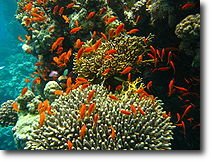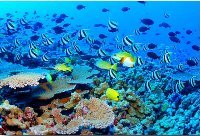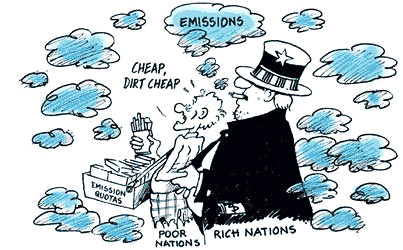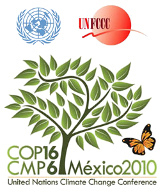Environmental Issues
Author and Page information
- This page: https://www.globalissues.org/issue/168/environmental-issues.
- To print all information (e.g. expanded side notes, shows alternative links), use the print version:
This part of the global issues web site attempts to highlight some of the environmental issues and concerns that have an affect on all of us — from what we do, to what we don’t do.
50 articles on “Environmental Issues” and 7 related issues:
Biodiversity
 The variety of life on Earth, its biological diversity, is commonly referred to as biodiversity. The number of species of plants, animals, and microorganisms, the enormous diversity of genes in these species, the different ecosystems on the planet, such as deserts, rainforests and coral reefs are all part of a biologically diverse Earth. Appropriate conservation and sustainable development strategies attempt to recognize this as being integral to any approach. In some way or form, almost all cultures have recognized the importance of nature and its biological diversity for their societies and have therefore understood the need to maintain it. Yet, power, greed and politics have affected the precarious balance.
The variety of life on Earth, its biological diversity, is commonly referred to as biodiversity. The number of species of plants, animals, and microorganisms, the enormous diversity of genes in these species, the different ecosystems on the planet, such as deserts, rainforests and coral reefs are all part of a biologically diverse Earth. Appropriate conservation and sustainable development strategies attempt to recognize this as being integral to any approach. In some way or form, almost all cultures have recognized the importance of nature and its biological diversity for their societies and have therefore understood the need to maintain it. Yet, power, greed and politics have affected the precarious balance.
Read “Biodiversity” to learn more.
Why Is Biodiversity Important? Who Cares?
 Why is Biodiversity important? Does it really matter if there aren’t so many species?
Why is Biodiversity important? Does it really matter if there aren’t so many species?
Biodiversity boosts ecosystem productivity where each species, no matter how small, all have an important role to play.
For example, a larger number of plant species means a greater variety of crops; greater species diversity ensures natural sustainability for all life forms; and healthy ecosystems can better withstand and recover from a variety of disasters.
And so, while we dominate this planet, we still need to preserve the diversity in wildlife.
Read “Why Is Biodiversity Important? Who Cares?” to learn more.
Loss of Biodiversity and Extinctions
 It has long been feared that human activity is causing massive extinctions. Despite increased efforts at conservation, it has not been enough and biodiversity losses continue. The costs associated with deteriorating or vanishing ecosystems will be high. However, sustainable development and consumption would help avert ecological problems.
It has long been feared that human activity is causing massive extinctions. Despite increased efforts at conservation, it has not been enough and biodiversity losses continue. The costs associated with deteriorating or vanishing ecosystems will be high. However, sustainable development and consumption would help avert ecological problems.
Read “Loss of Biodiversity and Extinctions” to learn more.
Nature and Animal Conservation
 Preserving species and their habitats is important for ecosystems to self-sustain themselves.
Preserving species and their habitats is important for ecosystems to self-sustain themselves.
Yet, the pressures to destroy habitat for logging, illegal hunting, and other challenges are making conservation a struggle.
Read “Nature and Animal Conservation” to learn more.
Climate Change Affects Biodiversity
 Rapid global warming can affect an ecosystems chances to adapt naturally.
Rapid global warming can affect an ecosystems chances to adapt naturally.
The Arctic is very sensitive to climate change and already seeing lots of changes. Ocean biodiversity is already being affected as are other parts of the ecosystem.
Read “Climate Change Affects Biodiversity” to learn more.
Coral Reefs
 One type of ecosystem that perhaps is neglected more than any other is perhaps also the richest in biodiversity—the coral reefs.
One type of ecosystem that perhaps is neglected more than any other is perhaps also the richest in biodiversity—the coral reefs.
Coral reefs are useful to the environment and to people in a number of ways. However, all around the world, much of the world’s marine biodiversity face threats from human and activities as well as natural. It is feared that very soon, many reefs could die off.
Read “Coral Reefs” to learn more.
Addressing Biodiversity Loss
 At the 1992 UN Conference on Environment and Development (the
At the 1992 UN Conference on Environment and Development (the Earth Summit
), the Convention on Biological Diversity (CBD) was born. 192 countries, plus the EU, are now Parties to that convention. In April 2002, the Parties to the Convention committed to significantly reduce the loss of biodiversity loss by 2010.
Perhaps predictably, that did not happen. Despite numerous successful conservations measures supporting biodiversity, the 2010 biodiversity target has not been met at the global level. This page provides an overview on how the attempts to prevent biodiversity loss is progressing.
Read “Addressing Biodiversity Loss” to learn more.
Biosafety Protocol 1999
The February 1999 Biodiversity Protocol meeting in Colombia broke down because USA, not even a signatory to the Convention on Biological Diversity, to which the protocol is meant to be part of, and five other countries of the "Miami Group" felt that their business interests were threatened. The safety concerns were unfortunately overridden by trade concerns. Some technological advances, especially in genetically engineered food, have been very fast paced and products are being pushed into the market place without having been proven safe. All over the world, concerned citizens and governments have been trying to take precautionary measures. However, 1999 was not a successful year in that respect.
Read “Biosafety Protocol 1999” to learn more.
Biosafety Protocol 2000
A Biosafety Protocol meeting was hosted in Montreal, Canada January 24 to January 28. Compared to the fiasco of the previous year, this time, there had been a somewhat successful treaty to regulate the international transport and release of genetically modified organisms to protect natural biological diversity. However, there were a number of important and serious weaknesses too.
Read “Biosafety Protocol 2000” to learn more.
Biodiversity Links for more Information
Read “Biodiversity Links for more Information” to learn more.
Climate Change and Global Warming
 The climate is changing. The earth is warming up, and there is now overwhelming scientific consensus that it is happening, and human-induced. With global warming on the increase and species and their habitats on the decrease, chances for ecosystems to adapt naturally are diminishing. Many are agreed that climate change may be one of the greatest threats facing the planet. Recent years show increasing temperatures in various regions, and/or increasing extremities in weather patterns.
The climate is changing. The earth is warming up, and there is now overwhelming scientific consensus that it is happening, and human-induced. With global warming on the increase and species and their habitats on the decrease, chances for ecosystems to adapt naturally are diminishing. Many are agreed that climate change may be one of the greatest threats facing the planet. Recent years show increasing temperatures in various regions, and/or increasing extremities in weather patterns.
This section explores some of the effects of climate change. It also attempts to provide insights into what governments, companies, international institutions, and other organizations are attempting to do about this issue, as well as the challenges they face. Some of the major conferences in recent years are also discussed.
Read “Climate Change and Global Warming” to learn more.
Climate Change and Global Warming Introduction
 The climate is changing. The earth is warming up, and there is now overwhelming scientific consensus that it is happening, and human-induced. With global warming on the increase and species and their habitats on the decrease, chances for ecosystems to adapt naturally are diminishing.
The climate is changing. The earth is warming up, and there is now overwhelming scientific consensus that it is happening, and human-induced. With global warming on the increase and species and their habitats on the decrease, chances for ecosystems to adapt naturally are diminishing.
Many are agreed that climate change may be one of the greatest threats facing the planet. Recent years show increasing temperatures in various regions, and/or increasing extremities in weather patterns.
This section looks at what causes climate change, what the impacts are and where scientific consensus currently is.
Read “Climate Change and Global Warming Introduction” to learn more.
UN Framework Convention on Climate Change
The world mostly agrees that something needs to be done about global warming and climate change. The first stumbling block, however, has been trying to get an agreement on a framework. In 1988, the Intergovernmental Panel on Climate Change (IPCC) was created by the United Nations Environment Programme (UNEP) and the World Meterological Organization (WMO) to assess the scientific knowledge on global warming. The IPCC concluded in 1990 that there was broad international consensus that climate change was human-induced. That report led way to an international convention for climate change, the United Nations Framework Convention on Climate Change (UNFCCC), signed by over 150 countries at the Rio Earth Summit in 1992. This section looks at this Convention and some of the main principles in it.
Read “UN Framework Convention on Climate Change” to learn more.
Reactions to Climate Change Negotiations and Action
The United States plus a few other countries, and many large corporations, have opposed climate change treaties seemingly afraid of profit impacts if they have to make substantial changes to how they do business.
However, as more climate change science has emerged over the years, many businesses are accepting this and even asking their governments for more action so that there is quick clarification on the new rules of the game so they can get on with their businesses.
This section explores some of those fears to see if they are justified or not.
Read “Reactions to Climate Change Negotiations and Action” to learn more.
Action on climate change is cheaper than inaction
Many are afraid that tackling climate change is going to be too costly. But increasingly, studies are showing action will not just be cheaper than inaction, but could actually result in economic, environmental and even health benefits, while improving sustainability.
Read “Action on climate change is cheaper than inaction” to learn more.
Global Warming, Spin and Media
 For many years, large, influential businesses and governments have been against the idea of global warming. Many have poured a lot of resources into discrediting what has generally been accepted for a long time as real.
For many years, large, influential businesses and governments have been against the idea of global warming. Many have poured a lot of resources into discrediting what has generally been accepted for a long time as real.
Now, the mainstream is generally worried about climate change impacts and the discourse seems to have shifted accordingly. Some businesses that once engaged in disinformation campaigns have even changed their opinions, some even requesting governments for regulation and direction on this issue.
However, a few influential companies and organizations are still attempting to undermine climate change action and concerns. Will all this mean a different type of spin and propaganda with attempts at green washing
and misleading information becoming the norm, or will there now be major shift in attitudes to see concrete solutions being proposed and implemented?
Read “Global Warming, Spin and Media” to learn more.
Climate Justice and Equity
For a number of years, there have been concerns that climate change negotiations will essentially ignore a key principle of climate change negotiation frameworks: the common but differentiated responsibilities.
Realizing that greenhouse emissions remain in the atmosphere for a very long time, this principle recognizes that historically:
- Industrialized nations have emitted far more greenhouse gas emissions (even if some developing nations are only now increasing theirs);
- Rich countries therefore face the biggest responsibility and burden for action to address climate change; and
- Rich countries therefore must support developing nations adapt—through financing and technology transfer, for example.
This notion of climate justice
is typically ignored by many rich nations and their mainstream media, making it easy to blame China, India and other developing countries for failures in climate change mitigation negotiations.
Development expert, Martin Khor, calculated that taking historical emissions into account, the rich countries owe a carbon debt
because they have already used more than their fair quota of emissions.
Yet, by 2050 when certain emission reductions are needed by, their reduced emissions will still add up to be go over their fair share:
However, rather than continue down the path of unequal development, industrialized nations can help pay off their carbon debt
by truly helping emerging countries develop along a cleaner path, such as through the promised-but-barely-delivered technology transfer, finance, and capacity building.
So far however, rich nations have done very little within the Kyoto protocol to reduce emissions by any meaningful amount, while they are all for negotiating a follow on treaty that brings more pressure to developing countries to agree to emissions targets.
In effect, the more there will be delay the more the poor nations will have to save the Earth with their sacrifices (and if it works, as history shows, the rich and powerful will find a way to rewrite history to claim they were the ones that saved the planet).
These issues are explored in more depth here.
Read “Climate Justice and Equity” to learn more.
Climate Change Flexibility Mechanisms
Flexibility mechanisms were defined in the Kyoto Protocol as different ways to achieve emissions reduction as part of the effort to address climate change issues. These fall into the following categories: Emissions Trading, Joint Implementation and Clean Development Mechanism.
However, these have been highly controversial as they were mainly included on strong US insistence and to keep the US in the treaty (even though the US eventually pulled out). Some of the mechanisms face criticism for not actually leading to a reduction in emissions, for example.

Image ©: Centre for Science and Environment
Read “Climate Change Flexibility Mechanisms” to learn more.
Carbon Sinks, Forests and Climate Change
A mechanism suggested for tackling climate change and warming has been the idea of using Carbon Sinks
to soak up carbon dioxide. To aid in this, reforestation, or planting of new forests, have been suggested. This is a popular strategy for the logging industry and nations with large forests interests. While there may be some potential in this solution, it cannot be effective on its own. This is because it legitimizes continued destruction of old-growth and pristine forests which are rich ecosystems and have an established biodiversity base (albeit shrinking now) that naturally maintain the environment (at no cost!). Creating new forest areas would require the creation of entire ecosystems. It is also criticized for being a quick fix that does not tackle the root causes effectively and does not lead to, or promote actual emissions reduction.
Read “Carbon Sinks, Forests and Climate Change” to learn more.
Global Warming and Population
It seems there has been a recent interest in associating climate change/global warming with “over population” and that countries such as China and India have to do more to help contain global warming.
Yet rich countries have a lot to do themselves. There were agreed reasons why developing countries were exempt from initial greenhouse gas emission targets: it was the emissions from rich countries that accumulated in the atmosphere for so long to trigger climate change.
Read “Global Warming and Population” to learn more.
Global Dimming
Research has shown that air pollutants from fossil fuel use make clouds reflect more of the sun’s rays back into space. This leads to an effect known as global dimming whereby less heat and energy reaches the earth. At first, it sounds like an ironic savior to climate change problems. However, it is believed that global dimming caused the droughts in Ethiopia in the 1970s and 80s where millions died, because the northern hemisphere oceans were not warm enough to allow rain formation. Global dimming is also hiding the true power of global warming. By cleaning up global dimming-causing pollutants without tackling greenhouse gas emissions, rapid warming has been observed, and various human health and ecological disasters have resulted, as witnessed during the European heat wave in 2003, which saw thousands of people die.
Read “Global Dimming” to learn more.
COP20—Lima Climate Conference
 An overview of the Climate Change Conference (also known as COP 20), held in Lima, Peru in December 2014.
An overview of the Climate Change Conference (also known as COP 20), held in Lima, Peru in December 2014.
While it seemed like it was a successful meeting, because developing nations were committed to drawing up their own plans for emissions reductions for the first time, a number of important issues were left undecided such as how financing would work.
This page is an overview of the Lima Climate conference.
Read “COP20—Lima Climate Conference” to learn more.
COP19—Warsaw Climate Conference
An overview of the Climate Change Conference (also known as COP 19), held in Warsaw, Poland in November 2013.
Predictably and sadly, the same issues have resurfaced: West stalling on doing anything, lack of funding, disagreement on priorities, etc.
This page is an overview of the Warsaw Climate conference.
Read “COP19—Warsaw Climate Conference” to learn more.
COP18—Doha Climate Conference
 An overview of the Climate Change Conference (also known as COP 18), held in Doha, Qatar in December 2012.
An overview of the Climate Change Conference (also known as COP 18), held in Doha, Qatar in December 2012.
Predictably and sadly, the same issues have resurfaced: lack of media coverage, West stalling on doing anything, lack of funding, disagreement on how to address it, etc.
This page is an overview of the Doha Climate conference.
Read “COP18—Doha Climate Conference” to learn more.
COP17—Durban Climate Conference
 An overview of the Climate Change Conference (also known as COP 17), held in Durban, South Africa in December 2011.
An overview of the Climate Change Conference (also known as COP 17), held in Durban, South Africa in December 2011.
Predictably and sadly, the same issues have resurfaced: lack of media coverage, West stalling on doing anything trying to blame India and China instead, lack of funding, disagreement on how to address it, etc.
Geopolitical threats (real and imaginary) quickly focus a lot of political will and money is easily found to mobilize military forces when needed.
The economy also takes center stage as the current pressing issue, while climate change is easily deferred, in the hopes that the West can let China and India pick up the burden of addressing emissions even though they have not contributed to the historical build up of emissions that have started the recent changes in the climate.
This page is an overview of the Durban conference.
Read “COP17—Durban Climate Conference” to learn more.
COP16—Cancún Climate Conference
 An overview of the Climate Change Conference (also known as COP 16), held in Cancún, Mexico in the December 2010.
An overview of the Climate Change Conference (also known as COP 16), held in Cancún, Mexico in the December 2010.
This conference came a year after the Copenhagen conference which promised so much but offered so little. It also came in the wake of WikiLeaks’ revelations of how the US in particular tried to cajole various countries to support an accord that served US interests rather than the world’s.
What resulted was an agreement that seems much watered down, even an almost reversal, from original aims and spirit of climate change mitigation. In effect, the main polluters (the industrialized nations) who should have borne the brunt of any emission reduction targets, have managed to reduce their commitments while increasing those of the developing countries; a great global warming swindle
if any!
Read “COP16—Cancún Climate Conference” to learn more.
COP15—Copenhagen Climate Conference
 An overview of the Climate Change Conference (also known as COP 15), held in Copenhagen, Denmark, in the middle of December, 2009.
An overview of the Climate Change Conference (also known as COP 15), held in Copenhagen, Denmark, in the middle of December, 2009.
There was a lot of hope and optimism before this conference that a meaningful climate negotiation could be agreed to, as climate change concerns are increasing rapidly.
Instead, a mixture of posturing from nations such as China and the US, and the inability for nations to agree on numerous issues led to a meeting failure.
But amongst the various reasons for failure are concerns that repeatedly show themselves every year at these climate conferences.
Read “COP15—Copenhagen Climate Conference” to learn more.
COP14—Poznań Climate Conference
 An overview of the Climate Change Conference (also known as COP 14), held in Poznań, Poland, at the beginning of December, 2008. As with past conferences, this too was not without its controversies. For example, while the Adaptation Fund was launched the funding of it caused lots of disagreements. The conference came at a time when Europe seemed to weaken their usually strong stance on climate change action and on news that in recent years, emissions from industrialized nations had risen.
An overview of the Climate Change Conference (also known as COP 14), held in Poznań, Poland, at the beginning of December, 2008. As with past conferences, this too was not without its controversies. For example, while the Adaptation Fund was launched the funding of it caused lots of disagreements. The conference came at a time when Europe seemed to weaken their usually strong stance on climate change action and on news that in recent years, emissions from industrialized nations had risen.
Read “COP14—Poznań Climate Conference” to learn more.
COP13—Bali Climate Conference
The UN conference on climate change held in Bali, Indonesia in December 2007 led to a final agreement known as the “Bali Roadmap”. The Bali Roadmap outlined a new negotiating process to be concluded by 2009 to feed into a post-Kyoto (i.e. a post-2012) international agreement on climate change. The Roadmap included a decision to launch an Adaptation Fund as well as further decisions on technology transfer and on reducing emissions from deforestation. However, as with past climate conferences, this was not without its controversies, especially Europe and developing countries’ criticisms of the US position and negotiation tactics.
Read “COP13—Bali Climate Conference” to learn more.
COP11—Montreal Climate Conference
December 2005 saw the eleventh session of the United Nations Framework Convention on Climate Change (UNFCCC) Conference of the Parties (or, COP11 for short). At the same time, the first Meeting of the Parties of the Protocol (MOP 1) took place. These meetings attempted to advance discussions on the future emission reductions and ways to help developing countries. The US walked out at one point of the meeting, but were eventually convinced to come back to the conference. The result, some felt, was a slightly weakened text, but something to build upon for the future. Developing countries were also discussed, but issues of climate justice and equity seemed to be missing once again.
Read “COP11—Montreal Climate Conference” to learn more.
COP10—Buenos Aires Climate Conference
December 2004 saw the tenth session of the United Nations Framework Convention on Climate Change (UNFCCC) Conference of the Parties (or, COP10 for short). This marked the 10th anniversary of the Kyoto Protocol. Countries were to discuss adaption measures, and the entry of the Kyoto Protocol into force. In addition, some discussion on post-Kyoto was also attempted.
Read “COP10—Buenos Aires Climate Conference” to learn more.
COP8—Delhi Climate Conference
October 23 to November 1, 2002 saw the eighth session of the United Nations Framework Convention on Climate Change (UNFCCC) Conference of the Parties (or, COP8 for short). Leading up to this conference there has still been little progress on reducing emissions.
Read “COP8—Delhi Climate Conference” to learn more.
COP7—Marrakesh Climate Conference
October 29 to November 9, 2001 saw the seventh session of the United Nations Framework Convention on Climate Change (UNFCCC) Conference of the Parties (or, COP7 for short). The purpose of the meeting was to agree legal text covering outstanding technical aspects of the political agreement reached in Bonn in July 2001 on how to implement the Kyoto Protocol. While an agreement resulted, there are still concerns there will be little impact on emissions as a result.
Read “COP7—Marrakesh Climate Conference” to learn more.
COP6—The Hague Climate Conference
November 13 to November 24, 2000 saw the sixth session of the United Nations Framework Convention on Climate Change (UNFCCC) Conference of the Parties (or, COP6 for short). Each COP meeting is where nations meet to evaluate the accords and compliance with meeting emissions reduction targets. This one was intended to wrap up three years of negotiations on the implementation of the Kyoto Protocol. Instead though, the talks pretty much collapsed.
Read “COP6—The Hague Climate Conference” to learn more.
COP4—Buenos Aires Climate Conference
November 2 - November 13, 1998 in Buenos Aires, Argentina the Fourth Meeting of the Conference of the Parties (COP-4) to the UN Framework Convention on Climate Change (UNFCCC) was held. There were many issues that still needed to be discussed, especially on the trading of Carbon emissions and equity between the rich and developing nations.
Read “COP4—Buenos Aires Climate Conference” to learn more.
COP3—Kyoto Protocol Climate Conference
1997, at the Conference of Parties III (COP3), Kyoto, Japan, the Kyoto conference on climate change took place. There, developed countries agreed to specific targets for cutting their emissions of greenhouse gases. A general framework was defined for this, with specifics to be detailed over the next few years. This became known as the Kyoto Protocol. The US proposed to just stabilize emissions and not cut them at all, while the European Union called for a 15% cut. In the end, there was a trade off, and industrialized countries were committed to an overall reduction of emissions of greenhouse gases to 5.2% below 1990 levels for the period 2008 - 2012. (The Intergovernmental Panel on Climate Change said in its 1990 report that a 60% reduction in emissions was needed...) As with the following COP meetings, there was enormous media propaganda by affected big businesses and by countries such as the U.S. who were openly hostile to the treaty. In fact one of the first things George Bush did when he came to power was to oppose the Kyoto Protocol.
Read “COP3—Kyoto Protocol Climate Conference” to learn more.
The Ozone Layer and Climate Change
Scientists believe that Global Warming will lead to a weaker Ozone layer, because as the surface temperature rises, the stratosphere (the Ozone layer being found in the upper part) will get colder, making the natural repairing of the Ozone slower.
Read “The Ozone Layer and Climate Change” to learn more.
El Niño and Climate Change
The 1997 Niño caused huge problems all over the world, from droughts to floods and poor yield of crops. It is thought that there is a link between climate change and the severity of Niño.
Read “El Niño and Climate Change” to learn more.
Climate Change Links for more Information
Read “Climate Change Links for more Information” to learn more.
Energy Security
 Energy security is a growing concern for rich and emerging nations alike. The past drive for fossil fuel energy has led to wars, overthrow of democratically elected leaders, and puppet governments and dictatorships.
Energy security is a growing concern for rich and emerging nations alike. The past drive for fossil fuel energy has led to wars, overthrow of democratically elected leaders, and puppet governments and dictatorships.
Leading nations admit we are addicted to oil, but investment into alternatives has been lacking, or little in comparison to fossil fuel investments.
As the global financial crisis takes hold and awareness of climate change increases, more nations and companies are trying to invest in alternatives. But will the geopolitics remain the same?
Read “Energy Security” to learn more.
Human Population
Read “Human Population” to learn more.
Populations: A Numbers Game
The human population of the planet is estimated to now have passed 6 billion people. But are large numbers themselves a problem? Europe for example, has higher population densities than Asia. There are more than two sides to the debate on whether population numbers equate to over-population or not.
Read “Populations: A Numbers Game” to learn more.
Stress on the environment, society and resources?
Does population affect and put stress on the environment, society and resources? Existing consumption patterns as seen in Europe and North America can put strain on the environment and natural resources. But how much of the environmental degradation we see today is as a result of over-population and how much is due to over-exploitation due to consumerism and geopolitical interests? Especially when considering that "[g]lobally, the 20% of the world's people in the highest-income countries account for 86% of total private consumption expenditures - the poorest 20% a minuscule 1.3%", according to the United Nations Development Programme's 1998 Human Development Report.
Read “Stress on the environment, society and resources?” to learn more.
Other Issues Affect and Get Affected by Population
How do human rights, conflict, trade/development patterns, and the environment come into all this? Poverty is the number one health problem, in developing and developed nations alike. Structural Adjustment policies, for example, from the IMF have not helped in many situations as social expenditure has had to be cut back. This has led to less investment in health, education and other basic services (things that have led to a better quality of life in Europe after the second world war). Coupled with corrupt rulers and dictators, often backed by the powerful nations, due to national geopolitical interests, a large number of people have suffered.
Read “Other Issues Affect and Get Affected by Population” to learn more.
Effects of Over-Consumption and Increasing Populations
The State of the World, 1999 Report from the Worldwatch Institute suggests that the global economy could be seriously affected by environmental problems, such as the lack of access to enough resources to meet growing population demands. Environmental degradation can contribute to social and political instability, which can lead to security issues. This has not currently been addressed by the foreign policy of many nations. Already around the world we are seeing an increase in violence and human rights abuses as disputes about territories, food and water are spilling into wars and internal conflicts.
Read “Effects of Over-Consumption and Increasing Populations” to learn more.
Gender and Population Issues
By ensuring women's rights can be upheld, and realizing that women play a crucial role in the development of society, many underlying issues which lead to conflict and problems can be tackled more effectively. Better care, education and rights for women mean that children should also benefit. This can eventually allow a society to enjoy more rights and the society can be enriched. Yet these very same provisions are being cut back, oftentimes as a result of harsh structural adjustment policies imposed by the IMF.
Read “Gender and Population Issues” to learn more.
Population Links for More Information
Read “Population Links for More Information” to learn more.
Natural Disasters
Read “Natural Disasters” to learn more.
Media and Natural Disasters
Media coverage of natural disasters seems to vary a lot depending on the disaster. Is it selective? Why do some regions get more attention than others? Even when millions have died in a region from conflict and war, how is it that a disaster that claims less in lives — sometimes in the same area, as in the case of the Democratic Republic of Congo — will bring in media interest and coverage? 2005 has recently seen a number of disasters and relief efforts, from the Asian tsunami, to the severe hurricanes and storms in the Caribbean, the earthquake in South Asia (Pakistan and India), and drought in parts of Africa. How has the media covered these?
Read “Media and Natural Disasters” to learn more.
Hurricane Katrina
What is the most damaging hurricane in US history, in its wake hurricane Katrina has also left other issues, from the handling of the disaster, to the media reporting, and rebuilding issues.
Read “Hurricane Katrina” to learn more.
Asian Earthquake and Tsunami Disaster
Boxing day, 2004, one of the largest earthquakes in recorded history (measuring 9 on the Richter Scale), struck just off Sumatra, Indonesia, in a fault line running under the sea. The rupture caused massive waves, or tsunamis, that hurtled away from the epicenter, reaching shores as far away as Africa. At least 230,000 people were killed and the livelihoods of millions were destroyed in over 10 countries. This has been one of the biggest natural disasters in recent human history.
Read “Asian Earthquake and Tsunami Disaster” to learn more.
Third World Debt and Disaster Recovery
When poor countries face natural disasters, such as hurricanes, floods, earthquakes, and fires, the cost of rebuilding becomes even more of an issue when they are already burdened with debt. Often, poor countries suffer with many lost lives and/or livelihoods. Aid and disaster relief often does come in from international relief organizations, rich countries and international institutions, but sometimes poor countries are still paying millions of dollars a week back in the form of debt repayment.
Read “Third World Debt and Disaster Recovery” to learn more.
Natural Disasters Links for More Information
This section lists various sites and organizations that provide more information or news on disasters as they unfold, or on disaster relief and recovery.
Read “Natural Disasters Links for More Information” to learn more.
Genetically Engineered Food
Read “Genetically Engineered Food” to learn more.
Consumption and Consumerism
Read “Consumption and Consumerism” to learn more.
Sustainable Development
Read “Sustainable Development” to learn more.
Author and Page Information
- Created:
- Last updated:
 Global Issues
Global Issues
